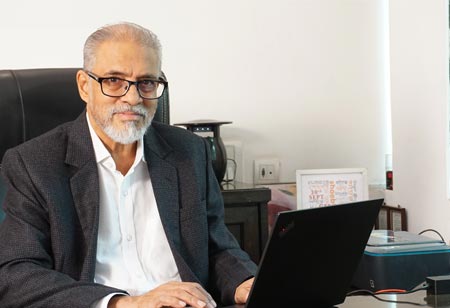
In an interaction with Thiruamuthan, Correspondent, Industry Outlook, Shoeb Kurawadwala, Founder & Managing Director of CN Water, discusses India’s gaps in meeting semiconductor-grade ultrapure water standards, urging global expertise, robust design, and sustainability to tackle local water quality challenges and ensure competitiveness.
Shoeb Kurawadwala brings over 20 years of expertise in pharmaceutical water treatment, specializing in Electro-Deionization, Ozonation, and process engineering, delivering high-purity, innovative, and efficient solutions to leading Indian and global pharmaceutical companies.
With semiconductor and pharma sectors driving India’s ultrapure water demand, how prepared is the domestic industry to deliver precision quality while ensuring cost competitiveness?
First, let’s differentiate between ultrapure water, as required by the semiconductor industry, and high purity water – HPW, WFI and so on - which are required in pharma. Both demand extremely stringent standards in terms of microbial limits, system design, and monitoring, but the context is different.
Most domestic water system providers have great capabilities for high-volume, general-use applications like municipal or industrial water. But in the semiconductors space, even a ppt (parts per trillion) level impurity is unacceptable.
Frankly, there is a humongous gap between their processes or capabilities and what the semiconductor industry expects. Most Indian companies lack deep expertise or hands-on experience in UPW system design. They would require experienced global partners for key technologies and design. The remaining equipment can be localized to ensure cost competitiveness. This has been the basis on which a few current projects are being executed.
Given the high economic impact of membrane fouling and scaling, what India‑specific water quality issues make ultra‑pure system inefficiency costlier and harder to manage effectively?
The challenge starts with the source water itself – high variability, low predictability – both in contamination and chemical composition. Problems like high TOC and TDS levels, which are common in Indian water sources, demand additional unit operations and treatment steps. It also needs strong process design engineering to prevent fouling and extend membrane life.
So, in the Indian context, a robust and elaborate pretreatment system becomes a necessary addition to the standard modules of UPW systems, making the overall solution costlier – both Capex and Opex wise.
Also Read: Pharmaceutical Third-Party Manufacturing: Benefits & Challenges
As smaller players underestimate engineering complexity, how does this miscalculation lead to costly project delays and market exits in India’s ultra-pure water sector?
Semiconductor companies looking for ultrapure water systems often underestimate how sharp the learning curve is for generic water system providers. Most have not lived through the engineering complexity and stability design challenges to achieve such extreme purity standards.
It's too early to talk about market exits; the manufacturing sector is very resilient. But we have seen a few aggressive ultrapure water bids in the market turn into execution challenges very quickly. I expect that many semiconductor companies will recalibrate their vendor strategy once they realize the depth of engineering and compliance that ultrapure water actually requires.
Considering validation and quality monitoring demand deep expertise, where do Indian practices fall short in meeting certification standards for ultra-pure water systems?
Some aspects of ultrapure water systems are non-negotiable. You need to understand SEMI and EPA standards, along with other aspects like loop integrity, TOC behavior trace contamination risks. Also, you have to design for traceability at every stage of the system’s lifecycle. In many cases, both customers and vendors lack a comprehensive audit trail or real-time visibility across processes and metrics.
But this is standard practice in pharma water systems which need to comply with USFDA, MHRA and the EU quality requirements. For us, documentation, traceability and alignment with regulatory demands are deeply embedded in our system design, as well as in our operational and maintenance practices. So, at CN Water, we are not starting from zero. We are adapting those pharma-grade principles and extending them to UPW, with stricter operating standards.
Also Read: Shaping India's Pharma Future with Innovation and Quality
With ESG mandates pushing sustainability, can ultra-pure water projects realistically meet extreme purification standards without raising operational costs and resource consumption significantly?
Not necessarily. In fact, sustainability and ultrapure standards can go hand-in-hand if the system is well-designed. In the pharmaceutical sector, for example, I can tell you that many organizations today are moving toward greater energy efficiency and net zero water practices. And we expect similar shifts in emerging sectors like semiconductors.
Sustainability outcomes depend largely on how much source water is drawn, how intelligently and efficiently it is processed. These are fundamentally driven by sound water system design and robust lifecycle management — whether in pharma, semiconductors, electronics, or any other water-intensive industry.
Which innovations will help Indian firms overcome costly failures and boost competitiveness in global ultra-pure water markets?
To be honest, most Indian companies have no experience in the design, installation, and operation of large-scale UPW systems. The first fabs and OSAT plants are still in the build phase, so it's premature to speak about innovation in this space.
As the industry matures and we gain 5–10 years of experience, I believe we will see meaningful innovation, particularly in pretreatment systems and lifecycle management, that address India-specific water quality challenges. To play on the world stage, Indian UPW companies will need to be highly competitive not just in cost, but also in quality, compliance and process excellence.
We use cookies to ensure you get the best experience on our website. Read more...